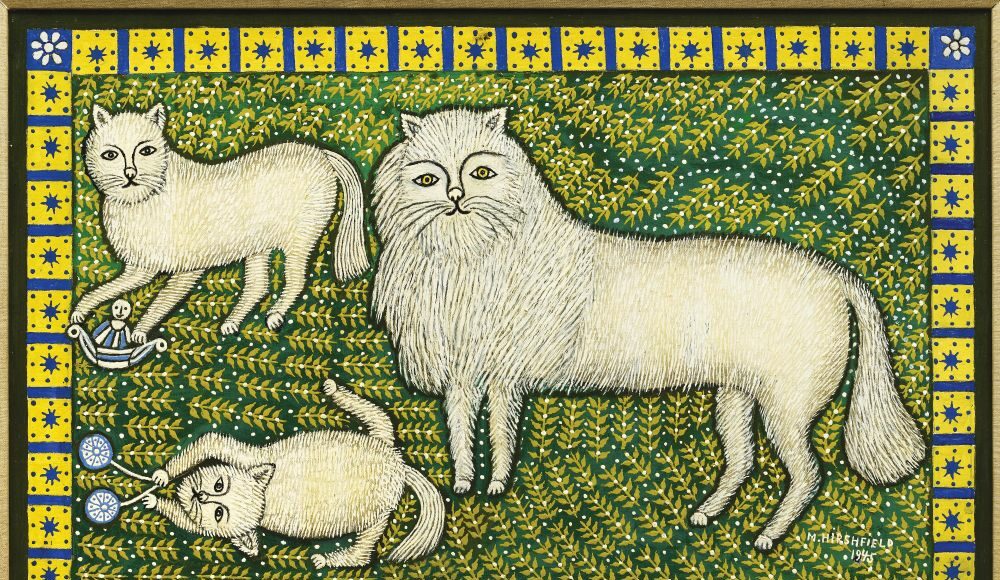Morris Hirshfield didn’t begin painting until he was 65.
With oil but without formal training, Hirschfield created fanciful, eerie images that seemed woven from thread: distorted lions, peering zebras, impossibly stiff female nudes. Pablo Picasso, Piet Mondrian and Marcel Duchamp—leviathans of the avant-garde—were among his fans. In 1943, he had a solo show at the Museum of Modern Art in New York City. By 1946, he was gone and his work was on its way to decades of obscurity.
But his story does not end there. After many years of research and writing, Stanford University art historian Richard Meyer curated Morris Hirshfield Rediscovered, an exhibition that opened at the Cantor Arts Center earlier this month. Praised as “one of the season’s best” shows by The New York Times upon its Fall 2022 launch at New York’s American Museum of Folk Art, it is the first retrospective of Hirshfield in over 75 years.
“Looking back on my career with the various subjects that I’ve done,” Meyer says, “one thing they all share is that I’m interested in stories that haven’t been told about art and artists by art history and lives that haven’t been remembered and artworks that have been forgotten.”
Meyer’s past subjects involved female, queer and politically radical 20th-century artists who were censored and repressed due to social stigma. Hirshfield’s near-erasure, however, was slightly more perplexing.
“More recently, I’ve been thinking about stories that don’t have to do with gender and sexuality centrally but really are about other forms of exclusion,” he says.
The key attribute that set Hirshfield apart from his famous modernist peers was his status—or rather, his lack of it. Born in Poland in 1872, Hirshfield immigrated to Brooklyn when he was 18. Like many other Jewish European immigrants of the time, he worked in the garment industry. He never gave up on his dream of painting, and only finally got around to it in retirement.
“I think you can see his expertise in design, in ornamentation, in pattern-making, in putting patterns together. You can see all that in the painting,” Meyer says. “Literally if you look at the skies, they look like yarn.”
In the exhibition and book, Meyer aims to show not just how Hirshfield’s work in the garment industry flowed into his painting, but also how that work was, in and of itself, art. By including artifacts from Hirshfield’s working life (with a rainbow array of fancy slippers he designed being the highlight) the exhibition challenges the harsh line art historians have typically drawn between the creativity of artists and that of artisans.
Why did such a fascinating figure fall into the shadows? Meyer’s answers to this core question could—and do—fill a book (his latest, Master of the Two Left Feet, accompanies the exhibition). But to paraphrase, Hirshfield’s brief moment in the limelight in 1943 spiraled into controversy as elite critics, collectors and curators began restricting their definition of modern art, relegating untrained painters to the relatively patronizing sub-genre of “folk” art.
“The last time MoMA had a self-taught show of a self-taught painter was in 1943,” Meyer says. “That was Hirschfield’s show.”
As Meyer was considering the reasons behind this mid-century gatekeeping, he arrived at the most surprising moment of his Hirshfield research.
“I realized that his paintings, which I argue often look like textiles—wool, tweed, terrycloth or yarn—reminded me of these very early images that I have of my grandmother surrounded by fabrics, sitting at her sewing machine.”
Meyer’s grandparents had lived in Brooklyn “not ten minutes” from the artist he’d been thinking about for years and had led similar hardworking and modest lives.
For Meyer, the ability to see his family’s story in Hirshfield’s further emphasized the artist’s importance. He began to think about how long and difficult the path is achieving one’s dreams in America.
“I wanted the book and the show to be about what it means to reinvent yourself. As an American, what are the pleasures of that, but what are also the problems?” he asks. He sees the strongest resonance with contemporary immigrants who, like Hirshfield, face a complex mixture of financial, political and racial barriers to their goals.
Ultimately, this tale of one slipper-maker’s very late-in-life recognition as a serious artist proves that legitimacy in the arts is often contextual. As Meyer says, “The ordinary can be special.”
Morris Hirschfield
Through Jan 21
Cantor Arts Center, Stanford
https://museum.stanford.edu/exhibitions/morris-hirshfield-rediscovered



